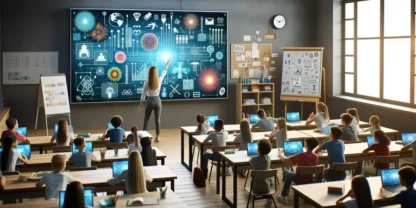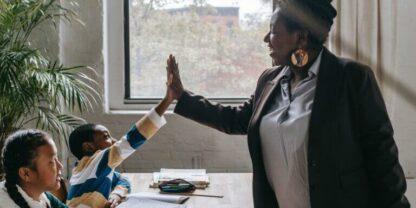Every year, the National Association for Media Literacy Education hosts a week of events to encourage kids to think critically when engaging with different forms of media. This year Media Literacy Week falls on the last week of October in 2022. Each day, students can celebrate one of five components that are key to media literacy: access, analyze, evaluate, create, and act.
There are plenty of reading activities you can develop around these themes. You can spend a whole class period focusing on media literacy or dedicate 10 minutes to sharpening the skills of your students before moving on to other lessons. Here are a few activities to consider for your MLW lesson plans to address media literacy.

Access
Access refers to how, when, and where people can engage with online information. It involves knowing how algorithms created by Google, TikTok, and Facebook present information. It covers equitable access in rural areas. Here are a few reading activities you can use to discuss this.
Elementary School
- Bring students to the library. Younger students can always benefit from a visit the to library. Ask the librarian or media center specialist to walk students through the different resources available. If some students don’t have access to the internet at home, how can they use the computers at school to look up information?
Middle School
- Create an internet activity journal. Ask students to write down every website they visit over 24 hours. Have them document how many times they visit sites like TikTok or YouTube. How much time do they spend on each site? How many videos do they watch or articles do they read?
Even before students can assess whether a piece of media is truthful or valuable, these activities can make them think about where they consume media and how often they engage with it.
Analyze
Analysis is one of the most important skills students can develop in regard to media literacy. Students can learn to stop whenever they engage with a video or article to learn about the creators and their objectives. If you develop a classroom of analytical students, you can increase the chances they grow into critical-thinking adults.
Elementary School
- Create an online article scavenger hunt. Ask students to highlight key elements of online articles. These can include the author, date published, news source, hooks, sources linked, images, and other key parts that make up an article.
Middle School
- Turn your students into fake media busters. Many fake news sites will try to look like trusted sources. Challenge your students to catch the differences between CNN.com and CNN.con. You can create a slide deck where students have to spot the differences.
These activities can help students stop disreputable news sources before they read them. This can help them avoid bias while saving time when researching topics.
Evaluate
The next step when analyzing information is evaluating its message and inferring any bias in the content. Even credible sources can present an agenda beyond providing information. These activities are meant to help students understand when forms of media are trying to persuade them toward certain beliefs they might not agree with.
Elementary School
- Read The True Story of the 3 Little Pigs! by Jessica Gunderson. Ask students to compare this story to the traditional telling of the Three Little Pigs. Which side is more believable? How did new facts in Gunderson’s book change the reader’s perspective on the Wolf and his motives?
Middle School
- Show students the media bias chart. Highlight how different news sources can skew in one direction or another with the Ad Fontes Media bias chart. Consider how reliability plays a factor. Ask: is there a correlation between bias and accuracy?
You might be able to cover topics like dog whistles, propaganda, tone of voice, and loaded language in this section. These discussions can be tied into history lessons (media control in authoritarian regimes) or current events if you feel safe bringing politics into your classroom.
Create
Kids and teens don’t just consume media, they also create it! When they share Instagram photos after a storm, they are citizen journalists. When they post opinions about celebrities, they are convincing others. Here are a few reading activities to help your students become media creators in a safe environment.
Elementary School
- Have a discussion about cyberbullying. StopBullying.gov has several resources you can use. Talk with students about how their posts on the internet can affect their friends.
Middle School
- Ask students to write letters to the school or local paper. Have them share opinions about a local community issue and make a case to persuade others. This could range from wanting more desserts in the cafeteria to asking the city to implement a recycling program.
Persuasion tools aren’t always bad. These activities show students how they can take the tactics they learned to recognize and apply them to their own content.
Act
The final day in Media Literacy Week covers action, or taking the next steps after engaging with a piece of content. For example, students might be more or less likely to vote for a candidate after seeing an election ad against them or hearing news about what they believe. These reading activities can help students reflect on how their actions are impacted by media.
Elementary School
- Use the feelings wheel. After reading a news article, ask younger students to identify how they feel and what the news makes them want to do. You can read a few articles to elicit happy, sad, angry, and confused feelings from your students.
Middle School
- Teach students to report or call out misinformation. Show students how they can report false information and accounts when they see them. Discuss some ways to comment on articles that are false. How can you tell a loved one online that they shared fake news?
Actions come in all shapes and sizes. They range from sharing articles to changing how you vote or treat people. These activities show how the actions you take after engaging with media are just as important (if not more) as the content itself.
Use Reading Activities to Highlight Daily Behaviors
Media Literacy Week dedicates five days to explore how students engage with content. However, most kids and adults go through each of these steps in a matter of minutes (or seconds) every day. You might see a headline that angers you before you read it. Your students might share an online trend that travels through your school like wildfire. The goal of this week is to teach everyone to stop and evaluate what they see before they react to it. You might be surprised how these reading activities stick with your students.
Looking for more activities?
Try out these FREE online games for Media Literacy Week:
- Summer Vacation
- Recommended for 4th-6th grade
- Skill: Reading comprehension
- Library Hunt
- Recommended for Kindergarten
- Skill: Identifying poems, storybooks, and informational texts
- Making Inferences
- Recommended for 4th-6th grade
- Skill: Making inferences based on text



